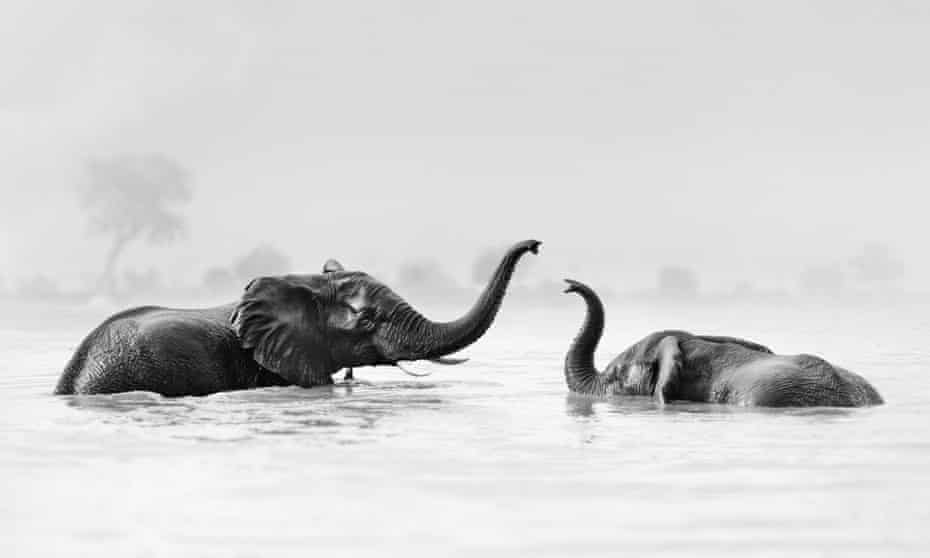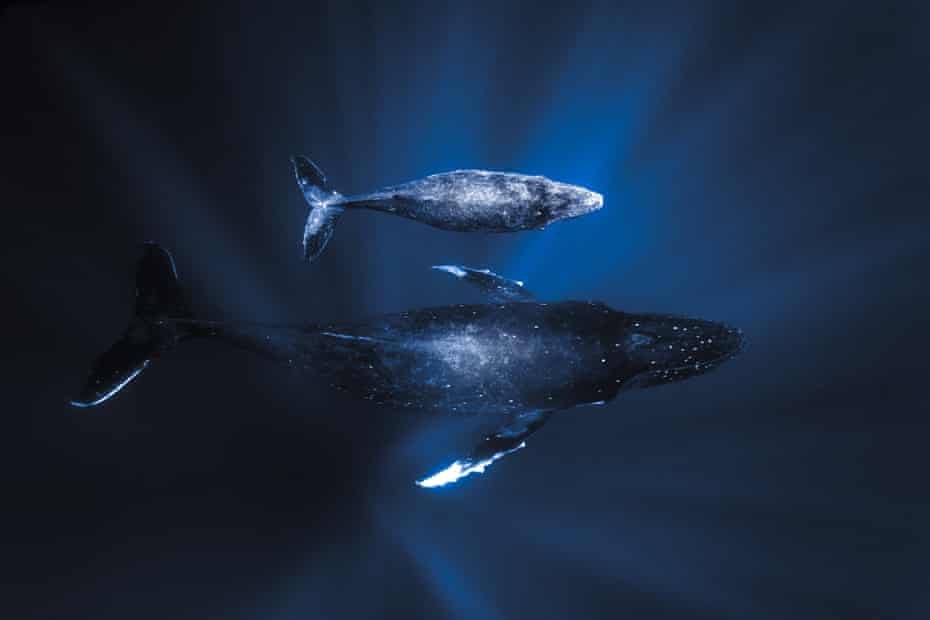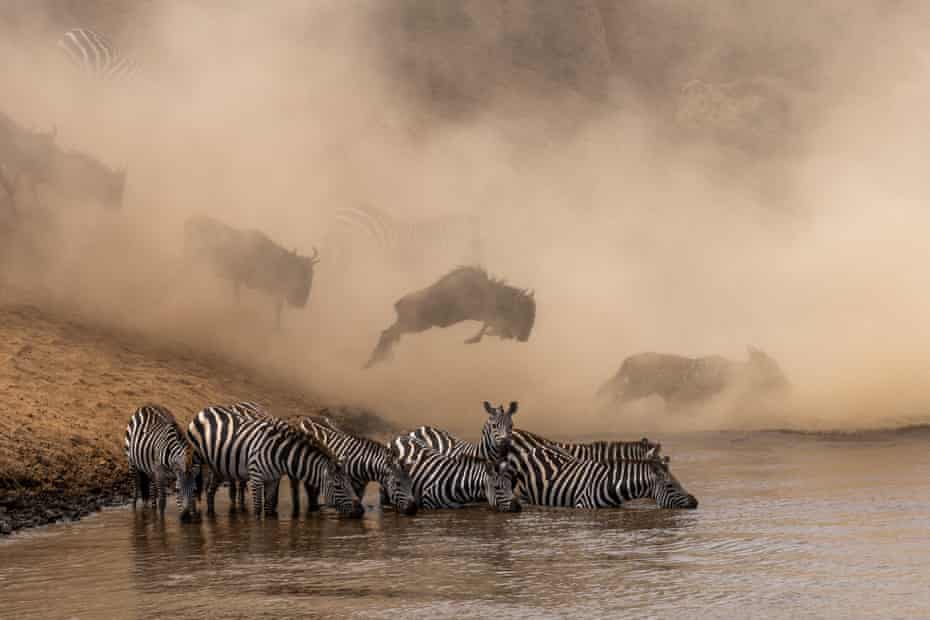
Elephants play at a waterhole in Trunk Puppets, by Tami Walker. All photographs courtesy of Prints For Wildlife
Five photographers share the story behind their shot, as images go on sale to support conservation charity
Graeme Green
Mon 12 Jul 2021
More than 150 wildlife photographers are taking part in a sale of wildlife prints to raise money for African Parks, a South Africa-based conservation NGO. In 2020, the first Prints for Wildlife sale raised $660,200 (£479,000), with more than 6,500 prints sold within 30 days.
This year, the initiative, founded by two photographers, Pie Aerts from the Netherlands and Austrian Marion Payr, is aiming to raise $1m. The prints will be on sale through the online shop printsforwildlife.org until 11 August.
Alongside some of the most respected wildlife photographers in the world, such as Greg du Toit, Beverly Joubert, Suzi Eszterhas, David Lloyd and Steve Winter, the sale also features emerging talent from developing nations, with the aim of promoting greater diversity among wildlife photographers.
The money raised will support African Parks, which manages 19 parks, spanning 14.7m hectares (36.3m acres), in 11 countries on behalf of governments in Africa, for the benefit of local communities and wildlife.
“Conservation was in crisis before the pandemic and continues to be during these unprecedented times,” says Andrea Heydlauff, chief marketing officer of African Parks. “In protecting Africa’s parks, we are securing functioning ecosystems, providing safe refuge for some of the world’s most threatened species, and supporting hundreds of thousands of people through employment, improved livelihoods, food security, education and healthcare.”
Here, five photographers share the story behind their images.
Five photographers share the story behind their shot, as images go on sale to support conservation charity
Graeme Green
Mon 12 Jul 2021
More than 150 wildlife photographers are taking part in a sale of wildlife prints to raise money for African Parks, a South Africa-based conservation NGO. In 2020, the first Prints for Wildlife sale raised $660,200 (£479,000), with more than 6,500 prints sold within 30 days.
This year, the initiative, founded by two photographers, Pie Aerts from the Netherlands and Austrian Marion Payr, is aiming to raise $1m. The prints will be on sale through the online shop printsforwildlife.org until 11 August.
Alongside some of the most respected wildlife photographers in the world, such as Greg du Toit, Beverly Joubert, Suzi Eszterhas, David Lloyd and Steve Winter, the sale also features emerging talent from developing nations, with the aim of promoting greater diversity among wildlife photographers.
The money raised will support African Parks, which manages 19 parks, spanning 14.7m hectares (36.3m acres), in 11 countries on behalf of governments in Africa, for the benefit of local communities and wildlife.
“Conservation was in crisis before the pandemic and continues to be during these unprecedented times,” says Andrea Heydlauff, chief marketing officer of African Parks. “In protecting Africa’s parks, we are securing functioning ecosystems, providing safe refuge for some of the world’s most threatened species, and supporting hundreds of thousands of people through employment, improved livelihoods, food security, education and healthcare.”
Here, five photographers share the story behind their images.
Will Burrard-Lucas – ‘the cubs approached inquisitively’

Curious lion cubs are captured by the BeetleCam in this image from Will Burrard-Lucas
I spent the first lockdown of 2020 completely redesigning and rebuilding my remote-control camera buggy, known as BeetleCam, and at the end of last year I took it out to Kenya. My aim was to get started on a new long-term project photographing the lions of the Mara North Conservancy in Kenya.
I introduced the Serian pride to my BeetleCam over a period of several weeks. The lionesses learned to completely ignore the buggy but it was a different story with the cubs. They remained very playful and would often approach to snarl at the camera or attempt to sneak up behind it and knock it over. This image is from an early encounter, as the cubs approached inquisitively through the long grass of the wet season.
Since starting this project, I’ve learned how all lions in the Maasai Mara are threatened by human-wildlife conflict. This often occurs when lions kill livestock on the outskirts of wildlife areas and are then poisoned in retaliation. It’s estimated that there are only about 20,000 lions left in the wild and that these occupy less than 5% of the species’ former range.
I spent the first lockdown of 2020 completely redesigning and rebuilding my remote-control camera buggy, known as BeetleCam, and at the end of last year I took it out to Kenya. My aim was to get started on a new long-term project photographing the lions of the Mara North Conservancy in Kenya.
I introduced the Serian pride to my BeetleCam over a period of several weeks. The lionesses learned to completely ignore the buggy but it was a different story with the cubs. They remained very playful and would often approach to snarl at the camera or attempt to sneak up behind it and knock it over. This image is from an early encounter, as the cubs approached inquisitively through the long grass of the wet season.
Since starting this project, I’ve learned how all lions in the Maasai Mara are threatened by human-wildlife conflict. This often occurs when lions kill livestock on the outskirts of wildlife areas and are then poisoned in retaliation. It’s estimated that there are only about 20,000 lions left in the wild and that these occupy less than 5% of the species’ former range.
Jono Allen – ‘this image was taken on a single breath’

A humpback whale and her calf taken by freediving photographer Jono Allen
My Prints For Wildlife photo is of a mother humpback and calf beginning their enormous journey south from the tropical waters of Tonga to the frozen waters of Antarctica. This image was taken on a single breath while freediving off the small island chain of Vava’u in Tonga, where the whales congregate each year to mate and give birth.
Advertisement
It’s impossible to truly understand these incredible creatures until you’ve been in the water with them. My perception will never be the same. A good biologist friend of mine has studied humpbacks for more than 10 years. She has seen thousands of whales in her time. We swam with these two whales together and within minutes of being face-to-face with them she was moved to tears.
This image is an important one to me because the humpback is one of the greatest conservation stories of our time. During the whaling era, they were brought close to extinction, but through the grace of protection and conservation they’re now back to their original numbers.
Supporting the conservation efforts of organisations such as African Parks is vital. If it wasn’t for such organisations, we would be living in a world without these two beautiful humpback whales.
My Prints For Wildlife photo is of a mother humpback and calf beginning their enormous journey south from the tropical waters of Tonga to the frozen waters of Antarctica. This image was taken on a single breath while freediving off the small island chain of Vava’u in Tonga, where the whales congregate each year to mate and give birth.
Advertisement
It’s impossible to truly understand these incredible creatures until you’ve been in the water with them. My perception will never be the same. A good biologist friend of mine has studied humpbacks for more than 10 years. She has seen thousands of whales in her time. We swam with these two whales together and within minutes of being face-to-face with them she was moved to tears.
This image is an important one to me because the humpback is one of the greatest conservation stories of our time. During the whaling era, they were brought close to extinction, but through the grace of protection and conservation they’re now back to their original numbers.
Supporting the conservation efforts of organisations such as African Parks is vital. If it wasn’t for such organisations, we would be living in a world without these two beautiful humpback whales.
Tami Walker – ‘frolicking in the water’

Trunk Puppets, Tami Walker’s image of elephants at the waterhole
Here are two elephants frolicking in the water at a pan on the south-eastern side of Hwange national park in Zimbabwe. The elephants seemed to be enjoying every moment: playing, splashing, climbing up on each other and submerging themselves. Several other herds of elephant and other game came to drink at the pan but nothing distracted these two from their fun and games.
During my years of photographing wildlife, I’ve come to realise how much wild animals are in balance with the natural order of things, with their surroundings and the natural cycles in which they survive and proliferate, and how much humanity is having a negative effect on that balance. I’ve come to understand just how vital wildlife is for the welfare and continuance of our great African heritage. The impact of human advancement and pressure on these wilderness areas is a challenge for my generation and those to come.
Here are two elephants frolicking in the water at a pan on the south-eastern side of Hwange national park in Zimbabwe. The elephants seemed to be enjoying every moment: playing, splashing, climbing up on each other and submerging themselves. Several other herds of elephant and other game came to drink at the pan but nothing distracted these two from their fun and games.
During my years of photographing wildlife, I’ve come to realise how much wild animals are in balance with the natural order of things, with their surroundings and the natural cycles in which they survive and proliferate, and how much humanity is having a negative effect on that balance. I’ve come to understand just how vital wildlife is for the welfare and continuance of our great African heritage. The impact of human advancement and pressure on these wilderness areas is a challenge for my generation and those to come.
OK MY FAVORITE
Nili Gudhka – ‘basking in the sun’

A cheetah cub at sunrise on the Maasai Mara in Kenya taken by Nili Gudhka
Just before sunrise in Kenya’s Maasai Mara national reserve, we found a cheetah mother with two cubs who were about three months old. The cubs became very playful as the sun rose and it got warmer. While the mother was surveying the area for food, the two cubs found a small tree. One of the cubs climbed on top and sat comfortably, basking in the sun.
The cheetah is Africa’s most endangered big cat. In the 19th century, there were 100,000 cheetahs living in the wild and today there are only about 7,000. This is due to human-wildlife conflict, habitat loss, climate change and, to me the most horrific issue, which is trafficking of cubs. Having spent countless hours with these beautiful cats, I’ve grown an emotional attachment to the species and hope that my work will be a means of advocating and conserving their existence.
The cheetah is Africa’s most endangered big cat. In the 19th century, there were 100,000 cheetahs living in the wild and today there are only about 7,000. This is due to human-wildlife conflict, habitat loss, climate change and, to me the most horrific issue, which is trafficking of cubs. Having spent countless hours with these beautiful cats, I’ve grown an emotional attachment to the species and hope that my work will be a means of advocating and conserving their existence.
Ketan Khambhatta – ‘leaving a cloud of dust’

Ketan Khambhatta captures the drama of a river crossing by zebra and wildebeest in the Mara Triangle in Kenya
I took this photograph at one of the river crossing points in the Mara Triangle, during the great migration of the wildebeest and zebras. I had been waiting in our vehicle for the wildebeest herds to cross the river and observed the zebras slowly moving forward to test the waters for crocodiles. But while the zebras were still checking, the wildebeest just started to run and jump into the river, leaving a cloud of dust and creating a dramatic moment that I thought would make for a great photo.
Being in the wild has increased my compassion towards wildlife. What became apparent during my photography trips is the threat that many animals face for various reasons, such as habitat loss, poaching and climate change.
Find more age of extinction coverage here, and follow biodiversity reporters Phoebe Weston and Patrick Greenfield on Twitter for all the latest news and features
I took this photograph at one of the river crossing points in the Mara Triangle, during the great migration of the wildebeest and zebras. I had been waiting in our vehicle for the wildebeest herds to cross the river and observed the zebras slowly moving forward to test the waters for crocodiles. But while the zebras were still checking, the wildebeest just started to run and jump into the river, leaving a cloud of dust and creating a dramatic moment that I thought would make for a great photo.
Being in the wild has increased my compassion towards wildlife. What became apparent during my photography trips is the threat that many animals face for various reasons, such as habitat loss, poaching and climate change.
Find more age of extinction coverage here, and follow biodiversity reporters Phoebe Weston and Patrick Greenfield on Twitter for all the latest news and features
No comments:
Post a Comment